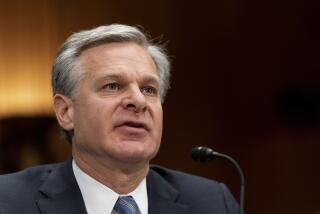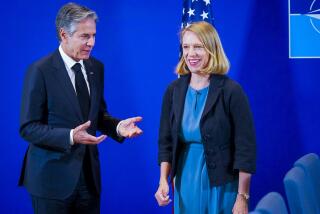New Soviet Embassy Sparks Furor : Washington Location Ideal for Electronic Eavesdropping
- Share via
WASHINGTON — Sen. Patrick J. Leahy recalls that in the 1960s, when he lived on some of the highest ground in Washington, near the site of the new Soviet Embassy compound, friends used to marvel at the clear picture on his television set.
Now, Leahy fears that reception will be just as good for the Soviets, and that their electronic eavesdropping and intelligence gathering will be facilitated.
“It’s sheer negligence . . . colossal, institutional negligence,” the Vermont Democrat said of the State Department decision more than a decade ago to allow the Soviets to build their embassy on the site. “There are times I wonder whether the State Department is working on our side or the Soviets’ side.”
To make matters worse, Leahy said, the site of the new U.S. Embassy being built in Moscow is “in a swamp,” near the Moscow River in one of the lowest parts of the Soviet capital.
Soviet diplomats and their families are living at the 10-acre compound in Washington on land 349 feet above sea level in the city’s Northwest section, but the offices are incomplete, and business is still being conducted at the old embassy.
Asked about the height controversy, Vladimir Kulagim, a spokesman for the Soviet Embassy, said the only advantage he sees is “fresh air,” and he said that to raise the issue of embassy sites is unfair.
“We were given this land by mutual agreement with the U.S. government. The U.S. Embassy has very good land in the center of Moscow,” he said. “Those who raise this question . . . just want to stir hatred to our embassy, to our personnel.”
Asked whether the site enhances Soviet abilities to intercept communications, Kulagim said, “I refuse to discuss this because it’s ridiculous.”
The agreement giving the Soviets use of the site--federal land where the Mount Alto Veterans Hospital once stood--and giving the United States its new site in Moscow was signed in 1972.
The Soviets had looked at other properties in the Northwest section of the city, where most of the foreign embassies are located. But they usually ran into opposition from residents concerned about a large compound being built in their neighborhood, said James E. Nolan Jr., director of the State Department’s Office of Foreign Missions.
Mount Alto was available, the federal government owned it and neighbors, used to living near a large compound, had little opposition, said Nolan, former counterintelligence chief for the FBI.
“I think that if everybody knew everything after the fact that they know now, maybe they wouldn’t have picked the Mount Alto site,” Nolan said. “I’m sure if they (State Department officials) didn’t think it was a good deal, they wouldn’t have made it. Whether we think it’s a good deal 13 years later seems to me a little late.”
Sen. Daniel Patrick Moynihan (D-N.Y.) said of the decision, “It was the easiest think to do but obviously was very mistaken.”
James Bamford, author of “The Puzzle Palace,” a book about intelligence gathering, said the Soviet Embassy is in a “key location” because a number of strategic microwave links, including ones from the Pentagon and the Central Intelligence Agency, pass over the hillside property. Bamford believes that four square structures enclosed in dark glass on each corner of the eight-story chancery--the tallest building in the compound-- are where the Soviets have their microwave receivers.
More to Read
Get the L.A. Times Politics newsletter
Deeply reported insights into legislation, politics and policy from Sacramento, Washington and beyond. In your inbox three times per week.
You may occasionally receive promotional content from the Los Angeles Times.










